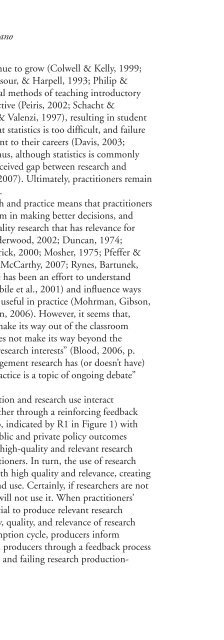WINTER 2012 - National Association of Schools of Public Affairs and ...
WINTER 2012 - National Association of Schools of Public Affairs and ...
WINTER 2012 - National Association of Schools of Public Affairs and ...
Create successful ePaper yourself
Turn your PDF publications into a flip-book with our unique Google optimized e-Paper software.
Creating Quality Online Course Design<br />
member’s). Having this point <strong>of</strong> view <strong>of</strong>ten reveals aspects <strong>of</strong> the<br />
course that could be improved to make navigation easier <strong>and</strong> improve<br />
the learning environment for the students.<br />
However, one caveat remains: The availability <strong>of</strong> technology doesn’t<br />
necessitate its use, <strong>and</strong> careful consideration is called for in determining what<br />
is lost <strong>and</strong> what is gained in the virtual classroom (Austin, 2009). For example,<br />
technological advancements are now allowing students to access their Bb<br />
courses from their Smartphones. Currently, communication on these devices<br />
is abbreviated, informal, codified “texting.” Can they B penalzd 4 respndg 2<br />
assgnmts w their thumbs? LOL.<br />
ACKNOWLEDGMENT<br />
The authors thank Dr. Fortune <strong>and</strong> Troy University faculty for providing<br />
interviews. We are also grateful to the anonymous reviewers for their comments<br />
on an earlier draft <strong>of</strong> this article.<br />
FOOTNOTE<br />
The QM rubric can be found at the Maryl<strong>and</strong>Online, Inc. website (www.qmprogram.org/rubric).<br />
REFERENCES<br />
Allen, E. I., & Seaman, J. (2010). Learning on dem<strong>and</strong>: Online education in the U.S., 2009. The Sloan<br />
Consortium. Needham, MA: Olin & Babson Colleges, Babson Survey Research Group. Retrieved<br />
from www.sloan-c.org/publications/survey/pdf/learningondem<strong>and</strong>.pdf<br />
Austin, E. K. (2009). Limits to technology-based distance education in MPA curricula. Journal <strong>of</strong><br />
<strong>Public</strong> <strong>Affairs</strong> Education, 15(2), 161–176.<br />
Beldarrain, Y. (2006). Distance education trends: Integrating new technologies to foster student<br />
interaction <strong>and</strong> collaboration. Distance Education, 27(2), 139–153.<br />
Bernard, R. M., Abrami, P. C., Lou, Y., Borokhovski, E., Wade, A., Wozney, L., et al. (2004). How<br />
does distance education compare with classroom instruction? A meta-analysis <strong>of</strong> the empirical<br />
literature. Review <strong>of</strong> Educational Research, 74(3), 379–439.<br />
Brooks, C. D., & Jeong, A. (2006). Effects <strong>of</strong> pre-structuring discussion threads on group interaction<br />
<strong>and</strong> group performance in computer-supported collaborative argumentation. Distance Education,<br />
2(3), 371–390.<br />
Brower, R., & Klay, W. (2000). Distance learning: Some fundamental questions for public affairs<br />
education. Journal <strong>of</strong> <strong>Public</strong> <strong>Affairs</strong> Education, 6(4), 215–231.<br />
Cavanaugh, C. (2001). The effectiveness <strong>of</strong> interactive distance education technologies in K–12<br />
learning: A meta-analysis. International Journal <strong>of</strong> Educational Telecommunications, 7(1), 73–78.<br />
Journal <strong>of</strong> <strong>Public</strong> <strong>Affairs</strong> Education 221

















